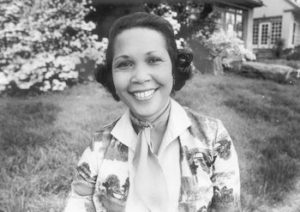
Barbara Johns Powell
*Barbara Johns Powell was born on this date in 1935. She was a Black librarian and civil rights activist.
Barbara Rose Johns was born in New York City, New York 1935. Her family had roots in Prince Edward County, Virginia, where they returned to live. Her mother worked in Washington D.C. for the U.S. Navy, and her father operated the farm where the family resided. Powell, the eldest of five children, had a younger sister, Joan Johns Cobbs, and three younger brothers, Ernest and Roderick, who served in Vietnam as a dog handler and were awarded the Bronze Star and Purple Heart. When her uncle Vernon visited Powell and her family, he would ask the children about black history. This motivated Powell and her siblings to study the subject, and Vernon and his outspoken nature influenced Powell and her siblings.
While living in Prince Edward County, Powell was educated in segregated public schools. In 1951, 16-year-old Barbara Johns was a junior at the all-Black Moton High School in Farmville. Across town was another school, open exclusively to white students. The resources available to each school and the quality of the facilities were unequal. Powell's school was designed and built to hold roughly 200 students, though enrollment was twice that number by 1951.
According to a first-person account from Powell's sister, Joan: “In winter, the school was very cold. And a lot of times we had to put on our jackets. Now, the students closest to the wood stove were very warm, and the ones who sat farthest away were very cold. And I remember being cold a lot of times and sitting in the classroom with my jacket on. When it rained, we would get water through the ceiling. So, there were lots of pails sitting around the classroom. And sometimes we had to raise our umbrellas to keep the water off our heads. It was a very difficult setting for trying to learn.
Parents of the Black students appealed to the all-white school board to provide a more extensive and properly equipped facility. As a stopgap measure, the board erected several tar-paper shacks to handle the overflow of students. Johns was frustrated with the separate and unequal facilities and decided to take action after missing her school bus and watching a bus for the white students pass her. She approached a trusted teacher to voice her concerns, and the teacher prompted her to take action. Johns met with several classmates, who all agreed to help organize a student strike. On April 23, 1951, her plan was put into action.
The school's principal was duped into leaving after being told that some students were downtown, causing trouble. While the principal was away, Johns forged a memo from that principal telling the teachers to bring their classes to a special assembly. The teachers brought their classes and left the assembly per request. She then delivered a speech to all 450 students, revealing her plans for a student strike in protest of the unequal conditions of the two schools. The students agreed to participate, and on that day, they marched down to the county courthouse to make officials aware of the difference in quality between the white and black schools. The student leaders went to the office of School Superintendent T. J. McIlwaine, who told them they were out of place.
Johns had hoped that the strike would end with the county officials sympathizing with the students and building them a new school but was instead met with indifference and struggle. For the remainder of the day, students picketed the school inside and outside, with placards proclaiming, "We want a new school or none at all" and "Down with tar-paper shacks." While the strike was being carried out, Johns and other fellow student leaders sought legal counsel from the NAACP (National Association for the Advancement of Colored People). The NAACP agreed to assist if the suit would be for an integrated school system, not just equal facilities.
On April 25, 1951, Oliver W. Hill and Spottswood Robinson, lawyers for the NAACP, arrived in Prince Edward County to help the Black students on strike. A month later, the NAACP filed Davis v. County School Board of Prince Edward County in federal court. The court upheld segregation in Prince Edward County, and the NAACP appealed to the U.S. Supreme Court. Davis v. Prince Edward County, along with four other cases, became part of the case Brown v. Board of Education. As Davis was the only case in Brown initiated by student protest, it is seen by some as a mentoring point of education in the 20th-century American Civil Rights Movement.
For her part in the integration movement, Johns was harassed, and the Ku Klux Klan burned a cross in her yard. Barbara Johns' parents, fearing for her safety, sent her to Montgomery, Alabama, to live with her uncle. After the strike, Barbara Johns lived in relative peace for the rest of her life. She married William Powell and raised five children. Her commitment to education led her to become a librarian. Barbara Rose Johns Powell died on September 25, 1991, and served in this profession until she died in 1991.